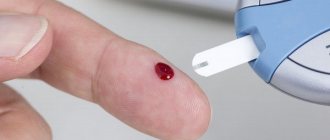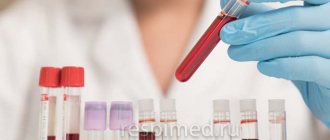Throughout the day, the level of glucose in the blood changes several times. The indicators are influenced by the qualitative and quantitative composition of food, physical activity, and neuropsychological state. The level of blood sugar after eating depends on the individual characteristics of carbohydrate metabolism. In older people, normative values shift upward due to an age-related decrease in cell sensitivity to insulin.
Some disturbances in the absorption of carbohydrates may occur in women during pregnancy and menopause. In a healthy person, ideal glucose levels after meals should not exceed 7.7 mmol/l (millimoles per liter - a unit of measurement of sugar). If the values are consistently elevated, diabetes mellitus or prediabetes is diagnosed. The prediabetic condition is characterized by the inability of body tissues to adequately absorb sugar, and glucose tolerance is impaired.
About glucose
Glucose is the main energy resource for the body and a source of nutrition for brain cells. Under the action of enzymes, food entering the intestines is broken down into individual components. Glucose molecules are formed from isolated saccharides and amino acids, most of which, after resorption (absorption) into the bloodstream, are transported to tissues and cells.
The role of the courier is played by the endocrine hormone of the pancreas - insulin. The liver converts the remaining unused sugar into glycogen (carbohydrate reserve). Whatever product the body processes, the level of glucose in the blood will increase. The degree of shift in sugar levels depends on the category of carbohydrates (simple or complex) present in the food eaten and the individual metabolic state of the person.
Objective data on glucose concentration (glycemia) can only be obtained by drawing blood on an empty stomach. In people with normal carbohydrate metabolism, the concentration of sugar in the blood relative to the internal environment of the body (homeostasis) remains at a stable level. When insulin sensitivity is impaired or insulin deficiency occurs, glucose accumulates in the blood, and cells and tissues remain “hungry.”
Sugar on an empty stomach
To determine glycemic values, capillary (from a finger) or venous blood is taken. In the second case, the figures may be slightly higher (within 12%). This is not a pathology. Before the study you must:
- Avoid drinking alcohol (three days before).
- Avoid food and oral hygiene in the morning (on the day of the test).
Important! If you prepare incorrectly on the eve of the analysis (sweets or alcohol for dinner, physical activity, nervous stress), the data may be distorted.
The results are assessed by comparing the obtained figures with standard values. Depending on the age category, the following fasting glucose levels are classified (in mmol/l):
| Children of preschool and school age | From puberty to 60 years | Elderly people up to 90 years old / 90+ |
| 3,3–5,6 | 4,1–5,9 | 4,6–6,4 / 4,6–6,7 |
For newborns and infants up to 3–4 weeks, the normative limits are 2.7 – 4.4 mmol/l. There are no differences in the laboratory examination results based on gender. With the exception of periods of changes in hormonal status in women (menopause, pregnancy). A prediabetic state is indicated by glycemic values on an empty stomach from 5.7 to 6.7 mmol/l.
In diabetics, glucose norms on an empty stomach are somewhat different, and determine the stage of the disease. Regulatory criteria for diabetic patients can be revised on an individual basis depending on the nature of the disease. You should not self-diagnose. To make a diagnosis of diabetes mellitus, it is necessary to undergo an extensive examination. A single discrepancy in sugar values does not 100% indicate the presence of pathology.
Norms and deviations
In case of persistent hyperglycemia, it is necessary to find out the reason for the deviation of the results. The most common is diabetes mellitus (prediabetes). Sometimes, there are other reasons for unstable sugar levels. To carry out advanced diagnostics, the patient is prescribed additional laboratory tests: GTT (glucose tolerance test), HbA1C analysis (quantitative assessment of glycosylated hemoglobin).
Important! Official diabetes is diagnosed only on the basis of a complete inpatient or outpatient examination of the patient.
Glucose tolerance test
Testing is a two-step blood test. Initially, biofluid is collected on an empty stomach. Blood is taken again 2 hours after the “glucose load”. The loading component is glucose (75 g) dissolved in water (200 ml). The patient drinks the liquid after the first test.
The glucose tolerance test determines the ability of body cells to metabolize glucose. Testing is mandatory for women during the perinatal period and patients aged 30+ who are suspected of having non-insulin-dependent diabetes. Impaired glucose tolerance is a condition of prediabetes.
Interpretation of GTT results (sugar in capillary blood in mmol/l)
| Diagnostic data | Fine | Prediabetes | SD |
| Before meals | < 5,5 | < 6,1 | > 6,2 |
| After load | < 7,8 | > 7,8–11,0 | > 11,1 |
In difficult cases, blood is drawn every 30 minutes. Based on the data obtained, a sugar curve is compiled and analyzed.
The amount of glycosylated hemoglobin (HbA1C) in the blood
Glycosylated (glycated) hemoglobin is a permanent combination of glucose and hemoglobin (the protein component of red blood cells). It is formed in the blood during the addition of a monosaccharide to a protein, and occurs without the participation of enzymes (non-enzymatic glycosylation). Hemoglobin does not change its structure inside red blood cells for 4 months. HbA1C analysis determines the retrospective glucose content, that is, the quality of carbohydrate metabolism is analyzed over the past 120 days.
Blood sugar levels in children
Glycated hemoglobin is measured as a percentage. In healthy children under 14 years of age, the HbA1C norm does not exceed 6%. A deviation of more than one (7%) means a high probability of developing diabetes. Age norm for adults:
- Up to 40 years – less than 6.5%, permissible deviations 6.5-7.0, with values >7.0% diabetes is defined.
- Over 40 – less than 7.0%, borderline values are 7.0-7.5, unacceptable excess of the norm – 7.5%.
- Age category 65+ – less than 7.5%, limit values 7.5-8.0, diabetes is diagnosed with results >8.0%.
For diabetics, HbA1C analysis is a means of monitoring the disease, assessing the risk of complications, and checking the effectiveness of therapy. Normal and abnormal values for diabetic patients are presented in the table.
Differentiating the type of diabetes
Consistently elevated results of all studies are an indication for testing the blood for the amount of antibodies to glutamate decarboxylase (GAD antibodies). The analysis is carried out to differentiate the type of diabetes. A healthy person maintains a certain level of GAD antibodies. Their permissible rate is 1.0 units/ml. When the content is exceeded, the test is considered positive, that is, type 1 diabetes is determined.
Important! Blood sugar can be either high or low. Both conditions indicate disturbances in the functioning of the body. To effectively eliminate them, it is necessary to identify the cause of unstable glycemia.
Indicators after meals
Laboratory diagnostics of blood for sugar immediately after eating is not carried out. To obtain objective results, biological fluid is collected at one-hour, two-hour and three-hour intervals after meals. This is due to the biological reactions of the body. Active production of insulin begins 10 minutes after food and drinks enter the gastrointestinal tract (gastrointestinal tract). Glycemia reaches its maximum limit an hour after food intake.
Results of up to 8.9 mmol/l after 1 hour correspond to normal carbohydrate metabolism in an adult. In a child, values can reach 8 mmol/l, which is also normal. Then the sugar curve gradually moves in the opposite direction. When measured again (after 2-2 hours), in a healthy body, glucose levels drop to 7.8 mmol/l and below. After passing the three-hour period, glucose values should return to normal.
Note: The female body absorbs food faster and releases glucose. The consumption of incoming energy occurs more rapidly than in men. This explains the fact that there are more women with a sweet tooth than lovers of sweets among the male half of the population.
The main time reference for diagnosing prediabetes and diabetes mellitus is 2 hours. Impaired glucose tolerance is recorded at values from 7.8 to 11 mmol/l. Higher rates indicate the presence of type 1 or type 2 diabetes. Comparative sugar levels (in mmol/l) in healthy people and diabetics (regardless of gender) are presented in the table.
| Absence of illness | 1 type | Type 2 | |
| on an empty stomach | 3,3–5,6 | 7,8–9 | 7,8–9 |
| an hour after eating | up to 8.9 | until 11 | until 9 |
| two hours later | up to 7 | to 10 | up to 8.7 |
| in 3 hours | up to 5.7 | until 9 | up to 7.5 |
To determine the borderline state of prediabetes and as part of the diagnosis of the true disease, a GTT (glucose tolerance test) is performed. Testing includes double blood sampling (on an empty stomach and after a glucose “load”). In laboratory conditions, the load is an aqueous solution of glucose in the ratio of 200 ml of water and 75 ml of glucose.
For diabetics, the level of sugar after meals depends on the stage of progression of the disease. In a state of compensation, indicators are close to healthy values. Subcompensation of the disease is characterized by certain deviations, since it becomes more difficult to normalize glycemia. In the stage of decompensation, it is almost impossible to bring the indicators back to normal.
HbA1C stands for glycated (glycated) hemoglobin. It is the result of the interaction between glucose and hemoglobin (the protein component of red blood cells). Inside erythrocytes (red cells), hemoglobin does not change throughout their life, which is 120 days. Thus, based on the indicators of glycated hemoglobin, the glucose concentration is determined in retrospect, that is, over the past 4 months. This analysis is extremely important for diabetics and the primary diagnosis of the disease. Based on its results, the state of carbohydrate metabolism in the body is assessed.
Average HbA1C according to the age category of patients
| Norm | Permissible deviations | Excess |
| up to 40 years old | ||
| <6.5 | 6.5–7.0 | >7.0 |
| 45+ | ||
| <7.0 | 7.0–7.5 | >7.5 |
| 65+ | ||
| <7.5 | 7.5–8.0 | >8.0 |
How many times the glycemic level can change per day depends on diet, physical activity, and the stability of the psycho-emotional state. An increase occurs after each meal, during irrationally planned sports training (or excessive stress during physical labor), and during nervous stress. The lowest rate is recorded during night sleep.
Blood test after meals and normal indicators
Throughout the day, the blood composition is transformed several times depending on physical activity, the quantity and quality of foods eaten, emotional stress, etc. A blood sugar test after eating allows you to assess the stability of carbohydrate metabolism in the body. To obtain unbiased data, biofluid (blood) is collected four times: once on an empty stomach and three times after meals (with an hour interval between procedures). The maximum glucose level is observed after 60 minutes. after eating.
The normal value (in adults) is 8.9 mmol/l (for children - about 8.0 mmol/l). Optimal results for assessing metabolic processes are recorded during repeated assessment (with a two-hour interval). Reference glycemic values are 7.7 – 7.8 mmol/l. After 3 hours, sugar should return to its original levels (fasting norm).
Comparative table of sugar indicators in mmol/l for healthy people with diabetes (diabetes mellitus)
| Time patient | Before meals | In one hour | 2 hours | After 3 hours |
| Healthy body | 3,3–5,5 | up to 8.9 | 7,7–7,8 | Up to 5.7 |
| Type 1 diabetes | 7,8–9 | up to 11.0 | up to 10.0 | No more than 9.0 |
| Type 2 disease | 7,8–9 | up to 9.0 | 8,5–8,9 | Not higher than 7.5 |
For reference: In the female body, the processes of formation, absorption and consumption of glucose are more rapid than in men. Therefore, a taste for sweets is more common among women.
Differences between hyperglycemia after meals and on an empty stomach
Hyperglycemia is a pathological condition of the body in which the glucose level systematically exceeds the norm. If sugar levels do not return to normal within the allotted three-hour interval, it is necessary to be diagnosed with diabetes mellitus or prediabetes. The development of diabetes is considered the main cause of hyperglycemia. Other factors that influence abnormal sugar levels before and after meals include:
- chronic pancreatitis;
- hidden oncological diseases;
- increased synthesis of thyroid hormones (hyperthyroidism);
- incorrect hormonal therapy;
- chronic alcoholism;
- hypertension and atherosclerosis;
- deficiency of macro- and microelements and vitamins in the body;
- systematic physical overload;
- abuse of monosaccharides and disaccharides (simple carbohydrates);
- constant psycho-emotional stress (distress).

In the absence of disease, the minimum values are 3.9 mmol/l, from 2 to 4 am
The main reason for a stable increase in blood sugar and the development of diabetes is obesity. The main symptoms that may indicate hyperglycemia are:
- physical weakness, decreased ability to work and tone, quickly onset fatigue;
- dysania (sleep disorder), nervousness;
- polydipsia (permanent feeling of thirst);
- pollakiuria (frequent urge to urinate);
- systematic headaches, unstable blood pressure (blood pressure);
- polyphagia (increased appetite);
- hyperhidrosis (increased sweating).
Due to the weak functioning of the immune system, acute respiratory viral infections and colds become more frequent.
Hypoglycemia before and after meals
Hypoglycemia is a forced decrease in glucose levels below the critical level of 3.0 mmol/l. At values of 2.8 mmol/l, a person loses consciousness. The reasons for the body's abnormal reaction after eating are:
How to measure sugar
- Prolonged refusal to eat (fasting).
- Strong emotional shock, often of a negative nature (stress).
- The presence of a hormonally active pancreatic tumor that synthesizes insulin in excess (insulinoma).
- Physical activity that is disproportionate to the body’s capabilities.
- Decompensated stage of chronic pathologies of the liver and kidneys.
Sugar levels decrease due to excessive uncontrolled consumption of alcoholic beverages. Ethanol has the property of inhibiting (blocking) the processes of food processing, the formation of glucose and its absorption into the systemic bloodstream. However, a person under the influence of alcohol may not experience acute symptoms.
When diabetes mellitus is diagnosed, the listed reasons are supplemented by incorrect insulin therapy for the first type of disease (unauthorized increase in insulin doses or lack of food intake after the injection), exceeding the prescribed dose of glucose-lowering medications (Maninil, Glimepiride, Glirid, Diabeton) in the second type of pathology. The state of reactive hypoglycemia is life-threatening.
Signs of lack of sugar in the blood: polyphagia, unstable psycho-emotional state (unreasonable anxiety, inadequate reactions to what is happening), autonomic failures (decreased memory, concentration), impaired thermoregulation (constantly cold limbs), rapid, rhythmic contractions of muscle fibers of the legs and arms (trembling or tremors), increased heart rate.

Energy deficiency is primarily manifested by low performance and physical endurance.
Disadvantages of Traditional Sugar Tests
Modern medicine is guided by the results of measuring fasting blood sugar levels, as well as a glucose tolerance test. This test asks a person to drink a solution containing 75 grams of pure glucose!
And the results are interpreted as shown in the table:
| Test type | Healthy man | Prediabetes | Diabetes |
| On an empty stomach | 3.9-5 mmol/liter (70-99 mg/dl) | 5.6-6.9 mmol/liter 100-125 mg/dl) | 7 mmol/l (126 mg/dl and above) |
| Tolerance test (1 hour later) | below 11.1 mmol/l (200 mg/dl) | ||
| Tolerance test (2 hours later) | below 7.8 mmol/L (140 mg/dL) |
Experts note that this test is unrealistic. In normal life, it is impossible to eat or drink 75 grams of pure glucose in one sitting (in carbonated drinks it is mixed with fructose, whose effect on blood sugar levels is different from glucose).
In addition, it is simply dangerous for people with even minor disorders of blood sugar regulation. As can be seen from the table, an increase in blood sugar levels in response to this solution to 11.1 mmol/l is considered normal!
At the same time, physiologically, a blood sugar level of 7.8 mmol/l and above leads to the destruction of beta cells of the pancreas, which produce insulin. This is a process that over time can lead to, among other things, the development of type 1 diabetes.
Measuring fasting sugar levels is not a reliable marker for predicting the risk of developing diabetes. Thus, both tests do not provide enough information to make correct conclusions about the state of the blood sugar regulation system.
Start your journey to improved well-being and quality of life today - join the free email training “5 Steps to Optimal Blood Sugar Regulation”!
Prevention of unstable glycemia in a healthy person
Normal blood sugar levels indicate the absence of carbohydrate metabolism disorders in the body. If the glucose level changes in one direction or another, you should resort to a number of preventive measures. This will help prevent (in some cases slow down) the development of pathological processes.
Preventive measures include:
- Changes in eating behavior. It is necessary to reconsider your diet and diet. Eliminate simple carbohydrates, fatty foods, fast food, and sweet carbonated drinks from the menu. Eat at least 5 times a day at equal intervals.
- Correction of physical activity. The load must correspond to physical capabilities. In addition, it is necessary to agree with your doctor which sports training is most suitable in each individual case (aerobic, interval, cardio, etc.).
- Refusal of drinking alcoholic beverages. The pancreas needs to be freed from alcohol load.
- Constant control over body weight (obesity leads to diabetes, anorexia can cause hypoglycemia).
- Regularly checking your sugar level (on an empty stomach and after meals).
- Strengthening the immune system. Hardening, systematic walks in the fresh air, course intake of vitamin and mineral complexes (before use, you must obtain consultation and approval from a doctor).
- Normalization of sleep. Night rest should be at least 7 hours (for an adult). You can eliminate dysania with the help of soothing decoctions and tinctures. If necessary, the doctor will prescribe medications.
Important! If you feel unwell, you should seek medical help. Simple fatigue can be a symptom of unstable glucose levels.







